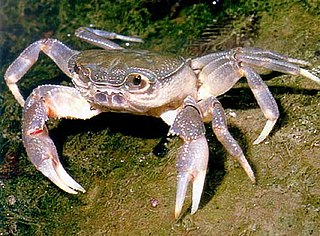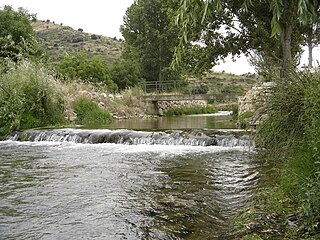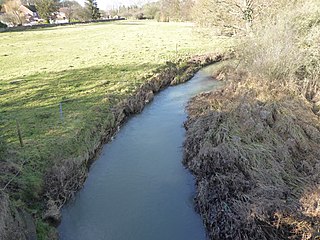
Crayfish are freshwater crustaceans belonging to the infraorder Astacidea, which also contains lobsters. Taxonomically, they are members of the superfamilies Astacoidea and Parastacoidea. They breathe through feather-like gills. Some species are found in brooks and streams, where fresh water is running, while others thrive in swamps, ditches, and paddy fields. Most crayfish cannot tolerate polluted water, although some species, such as Procambarus clarkii, are hardier. Crayfish feed on animals and plants, either living or decomposing, and detritus.

Astacidae is a family of freshwater crayfish native to Europe, western Asia and western North America. The family is made up of four extant (living) genera: The genera Astacus, Pontastacus, and Austropotamobius are all found throughout Europe and parts of western Asia, while Pacifastacus is native to western United States and British Columbia, but has also been introduced elsewhere.

Procambarus clarkii, known variously as the red swamp crayfish, Louisiana crawfish or mudbug, is a species of cambarid crayfish native to freshwater bodies of northern Mexico, and southern and southeastern United States, but also introduced elsewhere, where it is often an invasive pest.

Austropotamobius pallipes is an endangered European freshwater crayfish, and the only crayfish native to the British Isles. Its common names include white-clawed crayfish and Atlantic stream crayfish.

The Candover Brook is a 9.6 km (6.0 mi) chalk stream in the English county of Hampshire. It is a tributary of the River Itchen, which it joins near the town of New Alresford. The stream rises from springs just to the south of the village of Preston Candover.

Greenlee Lough is a lough or lake and national nature reserve 3 miles (5 km) north of Bardon Mill, and 1.5 miles (2.4 km) north of the B6318 road in Northumberland, northern England.

Austropotamobius torrentium, also called the stone crayfish, is a European species of freshwater crayfish in the family Astacidae. It is mostly found in tributaries of the Danube, having originated in the northern part of the Balkan Peninsula.

Austropotamobius is a genus of European crayfish in the family Astacidae. It contains four extant species,

Broomlee Lough is an inland lake in Northumberland, England at the southern edge of Northumberland National Park. The lough lies immediately north of the course of Hadrian's Wall. Old legends portray the lake as a repository of hidden treasure.

Halleypike Lough is an inland lake on Haughton Common at the southern edge of Northumberland National Park, northeast of Bardon Mill, and 1 mile (1.6 km) north of the B6318 Military Road in Northumberland, northern England. The lake is of Victorian origin and is fished.

Sagmariasus verreauxi is a species of spiny lobster that lives around northern New Zealand, the Kermadec Islands the Chatham Islands and Australia from Queensland to Tasmania. It is probably the longest decapod crustacean in the world, alongside the American lobster Homarus americanus, growing to lengths of up to 60 centimetres (24 in).

Potamon fluviatile is a freshwater crab found in or near wooded streams, rivers and lakes in Southern Europe. It is an omnivore with broad ecological tolerances, and adults typically reach 50 mm (2 in) in size during their 10–12 year lifespan. They inhabit burrows and are aggressive, apparently outcompeting native crayfish.

Stephanie Peay is a British ecologist and crayfish researcher.

The Huerva River is a river in Aragon, Spain. It is a tributary of the Ebro. Its mean annual discharge is only 67 cubic hectometres (54,000 acre⋅ft).
Carrickaport lough is a freshwater lake in Kiltubrid parish, south County Leitrim, Ireland. Drumcong village, and Lough Scur, lie nearby. Carrickaport lough is known for quality bream and pike fishing. The ecology of Carrickaport lough, and other county waterways, is threatened by curly waterweed, zebra mussel, and freshwater clam invasive species.
Keshcarrigan Lough is a mesotrophic freshwater lake near Keshcarrigan in County Leitrim, Ireland. Known for quality coarse fishing, the lake allows bank fishing from concrete stands on the northern shore, two with wheelchair access. The ecology of Keshcarrigan Lough, and other county waterways, is threatened by curly waterweed, zebra mussel, and freshwater clam invasive species.

River Ise and Meadows is a 13.5-hectare (33-acre) biological Site of Special Scientific Interest along the River Ise in Northamptonshire between Geddington and the Kettering to Corby railway line east of Rushton.

River Mease SSSI is a 23.0 hectares biological Site of Special Scientific Interest. It is a stretch of the River Mease and its tributary Gilwiskaw Brook, running between Alrewas in Staffordshire and Packington in Leicestershire. It is also a Special Area of Conservation The river goes through private land, but it is crossed by roads and footpaths.

Austropotamobius bihariensis is a species of crayfish in the family Astacidae. It is known to exist only in Romania being restricted to the rivers in the western Apuseni Mountains. Its proposed English common name is idle crayfish. It is supposed to have diverged/split ~15 Ma old from a common relative of A. torrentium from the Dinarides and evolved isolated due to the historically tectonic north-eastern movement of Tisza-Dacia mega-unit through the Pannonian Basin, during the Miocene. The molecular divergence in 582 base length nucleotides of COI mtDNA sequences is supported by 43 mutational steps, a differentiation of 7.4% from the sister clade of A. torrentium located in north-western Dinarides

Rafael Antonio Curra was a Venezuelan ichthyologist and university professor. He is considered one of the pioneers of oceanographic studies in his native country.


















